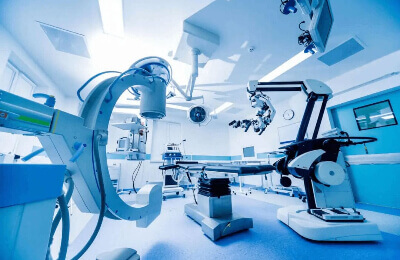Learn about the processes used to manufacture medical devices and the applications they’re relevant to, as well as the best practices to follow when designing medical devices.

The term medical device covers a wide range of applications from tongue depressors and latex gloves to x-ray machines, customised hearing aids and biomedical implanted devices such as heart valves. Traditional manufacturing processes such as CNC machining and injection moulding are typically used for the many existing medical devices such as prosthetics, surgical tools and general equipment/tools used by medical professionals.
The field of medical device manufacturing is growing rapidly, and given the advantages of additive manufacturing – highly customisable geometry, low cost, and a wide range of possible materials – these processes are well suited to meet the demand for new medical device manufacturing needs.
This article covers the processes commonly used to manufacture medical devices, as well as applications, best practices to follow and regulations to consider when designing and manufacturing medical devices, plus a quick look at what the future of medical device manufacturing could look like in a few years’ time. Feel free to skip to specific sections using the list below.
Whether additive or traditional manufacturing is the best solution for medical devices depends on a number of factors, including the overall timeline and application. Critical questions to consider include
The specifics of each CNC machining category are beyond the scope of this article, but factors that influence the type best suited for your application include part geometry and part material. CNC machines cover a wide range of cutting tools/machining processes and have applications suitable for all part geometries and materials found in medical device manufacturing.
CNC machining for medical devices is best suited for higher volumes and finished products due to the high start-up costs.
Use injection moulding for higher volume medical devices, such as laboratory equipment housings, plastic surgical components, syringes, containers, test tubes, and beakers.
A wide range of materials are available for injection moulding, including higher strength/durability plastics, higher flexibility including silicone plastics, sterilisable for dental and surgical tools and guides, and medical grade for biomedical implants.
Cost effective solution for simple geometries. Consider for iterative, low cost prototyping of medical devices or plastic medical devices where material strength is not a critical design attribute.
Several plastic materials are available, including materials compatible with biomedical implants and some sterilisable for surgical devices.
Use this process where you need a high level of detail and aesthetics. It results in parts with a smooth surface that you can paint.
Use medical device applications for low-cost prototypes, surgical and dental tools and guides, and some biomedical implants, such as hearing aids, where you do not need high material strength.
Parts have good strength and high accuracy.
Consider for surgical and dental tools and guides where strength requirements are similar to injection moulded nylon. PA12 nylon is also sterilisable for biomedical implants.
Best for complex designs and where material strength is a critical design attribute.
Metal printing has the most medical device applications of any additive manufacturing process due to the ability to print complex geometries, higher material properties and materials compatible with biomedical implants or sterilisable for surgical tools. Generally a more expensive option.
Given the broad category of products classified as medical devices – from tongue depressors and latex gloves to X-ray machines, customised hearing aids and biomedical implanted devices such as heart valves – there’s a wide range of applications for medical device manufacturing.
The field of medical device manufacturing is growing rapidly, and the application of medical device manufacturing includes well-established products as well as cutting-edge technologies. Medical device manufacturing includes device prototyping for modelling and validation, medical devices with complex geometries, modelling for simulation/training of medical professionals, and personal protective equipment.
Are you looking for a reputable partner for your parts fabrication and machining projects? Look no further. At PROTO MFG, we specialize in CNC machining and related technologies, including sheet metal fabrication, rapid prototyping, etc. Whether it is a project with a simple design or parts with complex geometries, do not hesitate to contact us today!